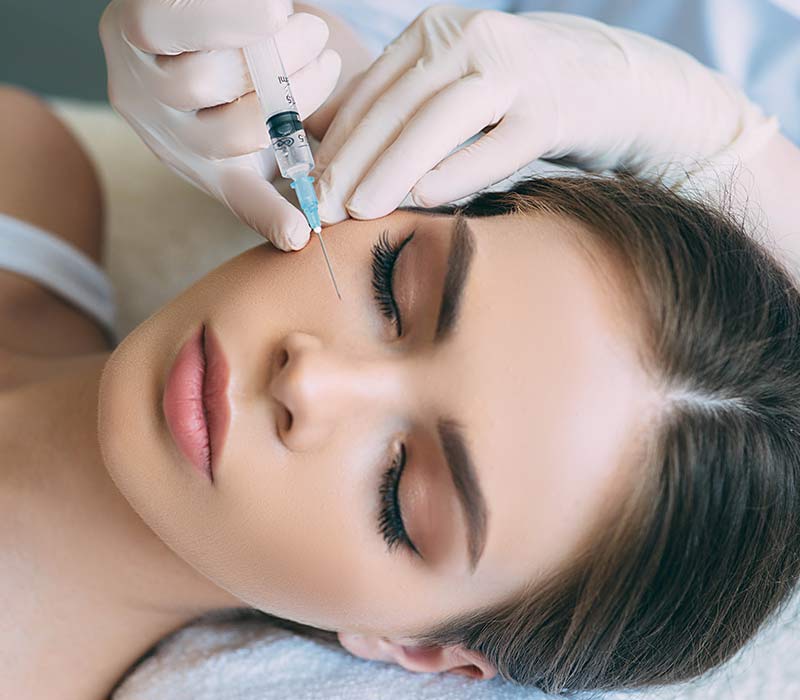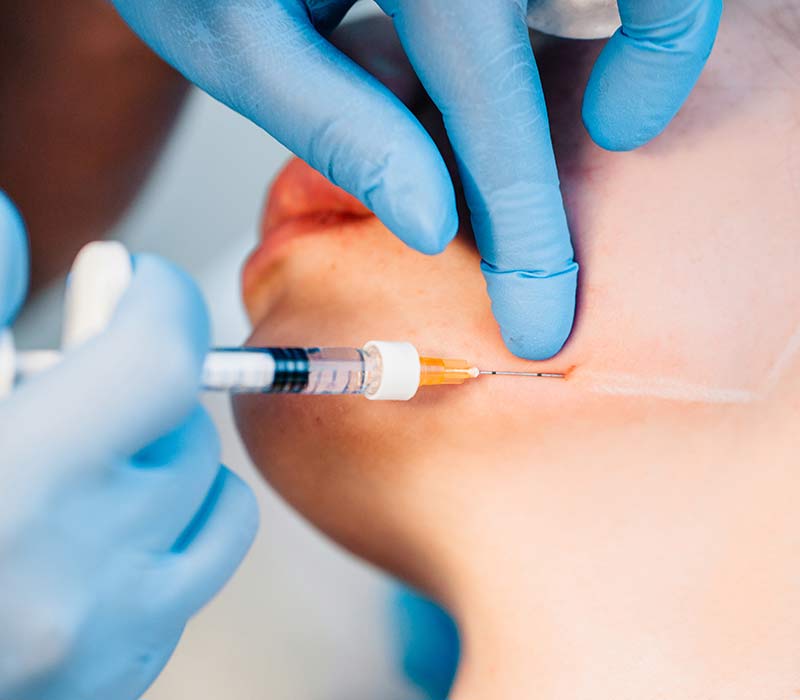

Dermal Fillers
Fillers, or dermal fillers are a man-made substance that mimics the body’s natural hyaluronic acid. Once injected, the fillers can improve your appearance by providing support to the skin, giving it more volume and better contouring.One of mainstream hyaluronic acid substance is ® Juvéderm. It is a hyaluronic acid injection gel produced by Allergan of the United States. It uses high concentration of hyaluronic acid in a highly cross-linked process to produce a homogeneous gel without particles, which is "single-phase smooth" hyaluronic acid. Compared with the traditional "dual-phase granular" hyaluronic acid, it is soft, smooth, and not easily degraded. Which has received strict certifications from European CE, US FDA, China CFDA and other countries’ drug administrations. In clinical use in more than 100 countries, the cumulative sales volume has exceeded 27 million. In general, our cosmetic injections are semi-permanent and will provide safe, long-lasting and natural looking results.
FAQs
Where can fillers be injected?
Despite their name, ‘dermal’ fillers are not commonly injected into the dermis or skin. They are mostly injected beneath the skin, usually in the subcutaneous fat layer or deeper. They are primarily used to shape, contour and proportion the face. Areas that can be treated include:
- Lips
- Cheeks
- Tear troughs
- Noses
- Chins
- Jawlines
- Foreheads
- Temples
Fillers are also commonly used for replacing volume on the face that occurs with ageing or weight loss. Cheeks and temple filler treatment are key examples of this.
It is possible to also inject dermal fillers into wrinkles or fine lines, although this is not their primary use. They are mostly injected deeper beneath the skin to volumise, contour and shape the face.
What types of dermal fillers are available?
(Due to TGA regulations, the dermal filler brand names cannot be mentioned)
The most commonly used fillers are composed of hyaluronic acid. Hyaluronic acid is found naturally in our bodies, including in our skin, eyes and joints. Unlike our own hyaluronic acid, chains of hyaluronic acid in fillers are cross-linked or bonded together. The thick gel-like consistency of fillers is a result of cross-linking. The amount of cross-linking determines filler thickness and longevity.
Thicker hyaluronic acid fillers are firmer as a result of greater cross-linking and can be used to volumise an area. Finer fillers with less cross-linking are generally used in areas where the skin is fine and smoothness is critical, such as around the eyes.
Hyaluronic acid fillers are reversible by injecting the enzyme hyaluronidase. This is useful for the treatment of misplaced or excess hyaluronic acid fillers.
Permanent fillers are available, however, these are much less commonly used. They have significantly higher side effects than temporary fillers. Also, they are not reversible unless surgically removed.
Collagen stimulators, although technically not dermal fillers, are also facial volumisers. Unlike dermal fillers, they actually stimulate the skin to produce more collagen and therefore thickness and volume. This process takes several months after the injections.
An example of one of the collagen stimulators is based on calcium microspheres. This is combined with a short-acting dermal filler, methylcellulose, that immediately and temporarily fills whilst the calcium microspheres stimulate new collagen production. Another collagen stimulator is based on poly-L-lactic acid, which is actually a type of suture material. Collagen stimulators are particularly suited to replenishing facial volume in those with global volume loss.
How long do dermal fillers last?
The generally accepted longevity of temporary hyaluronic acid fillers is from 6 to 18 months. We recently challenged this by performing MRI scans of patient’s faces who had hyaluronic acid fillers several years ago. In the vast majority of these scans, we found the fillers persisted. Our findings indicate temporary hyaluronic acid fillers may last for over 10 years in many cases. This finding correlates to our clinical observations also. We have often found fillers to last in areas such as the tear troughs for over 10 years. The eye area has fine skin making it possible to discern the presence of filler without an MRI scan.
Despite their unexpected longevity, the reversibility of hyaluronic acid fillers with an enzyme called hyaluronidase is still possible at any time.
Given the possible longevity of fillers, we consider it important to use smaller amounts at very infrequent intervals. This will prevent accumulation of fillers and over-filling of the face.
How much filler should I have?
It is common practice to inject one mL of filler into each part of the face. For example, 1mL is a common volume injected into the lips. This tendency could be due to the fact that fillers are mostly packaged and sold in 1mL syringes. Furthermore, as the expected longevity of hyaluronic acid fillers is typically 6 to 18 months, fillers typically get re-injected every 6 to 18 months. However, our recent MRI study findings suggest that filler lasts much longer – often many years. Therefore, if 1mL of filler is injected into each area of the face every 6 to 18 months, overfilling may result.
Often we advise using 1mL of filler for multiple areas on the face rather than just in one area. This allows for a more balanced approach to filling the face. Small amounts are put in each area rather than a whole mL or more in each area. With careful placement, it is possible to use smaller amounts to achieve better results without overfilling the face. The face should be carefully assessed before each filler session to determine the need for filler. Putting in fillers at regular 6 to 18-month intervals with regard for the aesthetic outcome is likely to lead to overfilling and poor outcomes.
What should I expect after having dermal fillers?
There is usually some transient redness after the injections. Swelling is also present after the procedure, especially with any lip enhancement procedure. Immediately post-procedure, the results seen in part. Full results occur after some weeks. During this time, the swelling subsides, the filler ‘hydrates’ and integrates into the tissues of the face.
Bruising can also occur, and if it does, it can take normally take a week or two to completely disappear.
Asymmetry is also possible, but correctable on a subsequent visit. Small lumps can occur, and these will either dissipate in a few weeks or may require dissolving with a different injectable product called hyaluronidase. For treatments around the eyes, puffiness can occur, and if present after one week, it will most commonly require hyaluronidase to correct. Corrections can be made a subsequent follow-up visit and filler can be added or removed during this time.
Infection is a rare complication of dermal filler injections. Bacterial infections and viral infections (such as cold sore reactivation) can occur post-filler treatment. We help to prevent these complications through proper cleansing of the skin with antiseptic prior to treatment. Note that if you have a history of cold sores and the treatment area is around the mouth, then you should notify your treating doctor as filler treatment can cause cold sore flare-ups. You may be instructed to take anti-viral medications prior to treatment if this is the case.
Injection of fillers directly into a blood vessel, or occlusion of a blood vessel from filler injections is also a rare but serious side effect of dermal filler injections. To avoid this, we tend to use blunt-tip cannulas rather than needles to inject the filler product. Blunt-tip cannulas actually can help to avoid blood vessels by pushing them away instead of entering them. Practitioner knowledge of the vascular anatomy of the face can also help in avoiding accidental injection into blood vessels. Unusual changes in the skin post-treatment, such as sudden blanching, redness, or even acne-like pustules are often signs of vascular occlusion.
Generally, dermal filler treatment is a very safe, non-surgical treatment for volumising and shaping the face. They have been used safely for cosmetic reasons for over 20 years.
What is the difference between anti-wrinkle injections and dermal fillers?
Despite having different actions, they are commonly used in conjunction with each other.
Anti-wrinkle injections relax the muscles of facial expression that crease and wrinkle the skin and provide no additional volume to the face. The typical longevity of anti-wrinkle injections is from 3 to 4 months.
Conversely, dermal fillers are injected to shape, contour and volumise the face. The longevity of fillers is significantly longer than anti-wrinkle injections.



